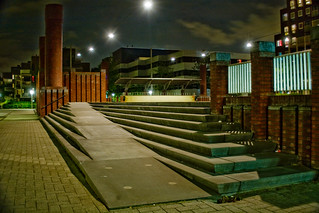 |
| CC Image: Handle by MoneyBlogNewz |
 |
| CC Image: THIS CAUGHT by Hernan Pinera |
 |
| CC Image: ramp stairs by Simon Claessen |
Universal Design for Learning (UDL) approach is more proactive than providing accommodations. If we correctly follow UDL principles we design learning for all learners; so we may not have to provide individual accommodations as the learning content is accessible by all learners.
Principles of Universal Design
- Equitable Use
- Flexibility in Use
- Simple and Intuitive Use
- Perceptible Information
- Tolerance for Error
- Low Physical Effort
- Size and Space for Approach and Use
Universal Design Networks
Universal Design Networks encourage multiple means of representation, engagement and action and expression.
Affective Network
This is the motivation for learning and it plays a big role in learner's engagement with the learning. Why? what is in it for me? are some of the questions that affective network needs to answer to keep the students engaged. Strategies can be recruiting interest (information that do not get learners attention is inaccessible - can try allowing choice or by personalisation, help make connections to prior knowledge); self-regulation (if learners do not see their progress they will not keep at it - self assess checklists, clear evaluation criteria, feedback); sustaining effort and persistence (short and long term goals, varying challenge levels).
Strategic Networks
How learners demonstrate mastery or competency of what they have learned is shown in strategic networks. It is the 'how' of learning; how can you express your mastery of learning. Providing them with multiple means of action and expression is a way to support this. Provide choice (allow learners to show what they know in different forms/ways) and support (allow small group discussions, detailed directions, rubric, check list, feedback).
Everybody is a genius. But if you judge a fish by its ability to climb a tree, it will live its whole life believing that it is stupid. -Albert Einstein-
Recognition Networks
This is about how learners understand information. It relates to presenting information in the course - providing multiple representations of information: auditory, text, visual, demonstrations etc. It is the 'what' of learning. A great example used in #AccessMOOC was giving directions to a driver. If someone told me take north exit I may not get very far. If they related it to a landmark or draw a map it may be easier for me. It would be very good if I had Google maps (voice and map) with me to find my way. It shows that for various learners, in this case person finding their way, different ways of representing information is useful. Supporting means could be provide options for perception (text, audio, visual - ways to customise say change font size, colour); provide options for language mathematical expressions and symbols (glossary, key notations); provide options for comprehension (chunk content with key learning points, ask for previous knowledge and relate).
This blog post is based on what I learnt in #AccessMOOC week 3
Universal Design for Learning: Theory and Practice by Anne Meyer, David H. Rose, and David Gordon is a good read (after creating an account the book is available online for free)
Universal Design for Learning: Theory and Practice by Anne Meyer, David H. Rose, and David Gordon is a good read (after creating an account the book is available online for free)
